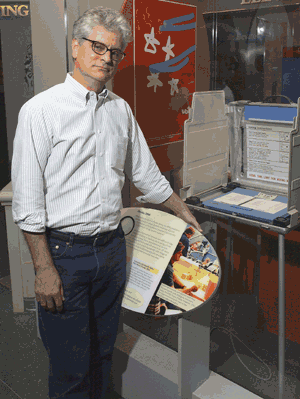Survival Guide: Larry Bird, Smithsonian Institution curator

U.S. elections have always been controversial, especially when it comes to deciding who gets to vote and how votes are counted, said Larry Bird, a curator at the Smithsonian Institution's National Museum of American History.
U.S. elections have always been controversial, especially when it comes to deciding who gets to vote and how votes are counted, said Larry Bird, a curator at the Smithsonian Institution's National Museum of American History. Bird began researching museum's exhibit, "Vote! The Machinery of Democracy," during the Palm Beach County, Florida, recount after the 2000 presidential election. He spoke with Staff Writer Gail Repsher Emery about the role of technology in American voting. Do you think there is one right way to vote? Every system has some failing. The right way to vote would be one that has multiple backup systems, redundant counting measures. You would be able to replay what happened, find out where the fault was and take steps to correct it.The best method may be one thing for an area of the country that has lots of people. There may be a better method for another part of the country that is lightly populated, where it is physically possible to easily and quickly count handwritten ballots. Like in Dixville Notch, New Hampshire. We start the exhibit with a map that shows the patchwork of methods. I think most people are familiar with the machines or the method that they use in their state or their city, but most people express surprise that there are six general methods by which people vote. Almost everything we have tried is still in use in some small corner of the country today. Do you think it would be better if we had one method? No. I think it would be easier to game if you had one method. If you have an electronic system, I think you need to have an open-source code that would be available for inspection by the state, not just the vendor. You need to see what is happening. Moreover, you need to instill confidence in whatever system you have chosen. It isn't for the convenience of the supervisor of elections; it's to instill confidence in the citizenry that they serve. Do you think some electronic voting methods are purely for the convenience of the people counting the votes? The dirty little secret of American electioneering is that many supervisors of elections, given the choice, will opt out of being responsible for collecting paper at the conclusion of their election. That's quite apparent in looking at the map. Anywhere you see purple, that's an electronic system, and with the exception of the state of Nevada and its 17 counties, they didn't order printers for their systems. Although in fairness, anywhere where you see green, they are using optically scanned ballots that begin and end with the voter making marks on a paper ballot that is then retained by the supervisor of elections. It functions as a physical check that you can trace back to the act of voting. I think that would win my confidence as a voter. I am a fan of the old gear-and-lever machine, in which I learned to cast a vote for the first time. It has a physical presence, unlike a flat screen, where it's like 'Did I touch it? Did I vote? What just happened?' There is no doubt when you close the curtain on a gear-and-lever machine what just happened. You freed up all those little levers, and you are now making your choices ? in steel. When you open the curtain, it has a resounding kind of a thud or ka-chunk to it. What did you learn from studying the 2000 episode in Palm Beach County, where a butterfly ballot design confused voters, and ballot cards were misaligned in the voting machine, allowing for off-center punches? I was fascinated with the way in which they organized themselves to recount. They had teams of four people ? two Democrats and two Republicans. They sat down in front of a pile of cards, and the Democrat would count while the Republican watched. On the other side of the table, the Republican would count and the Democrat would watch. There was no discussion except to say that they had a problem with a certain ballot. The problem card would be forwarded down into the well. That's where the decision was made on how to count it. ? That to me was a powerful statement. If they had to review every card, they were going to do it. If you developed this exhibit 20 years from now, what would it look like?

WT:
Bird:
WT:
Bird:
WT:
Bird:
WT:
Bird:
WT:

Larry Bird, a curator at the Smithsonian Institution's National Museum of American History
WT:
Bird:
WT:
Bird:
WT:
Bird:
WT:
Bird:
WT:
Bird: The map probably will become one or two colors. You'll probably have electronic systems with multiple backup means. Whether or not that includes paper, I don't know. Then you'll have optical scan systems that begin and end in paper, that are used in lightly populated areas of the country.d
NEXT STORY: LastByte